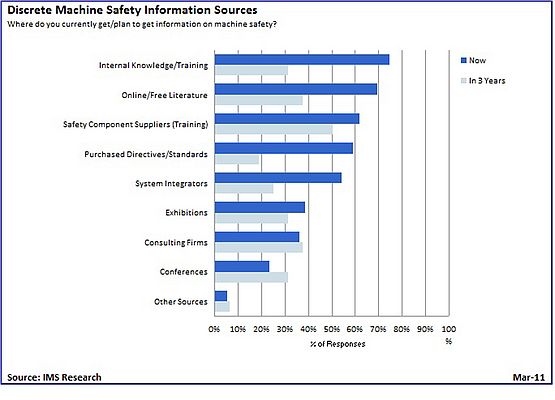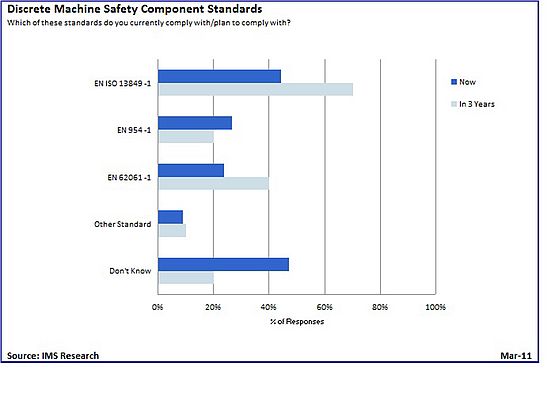Entering into the minefield of discrete machine safety standards can be a daunting experience, preliminary data from a new latest user survey from IMS Research indicates. The results clearly show that many users of machine safety components in EMEA are unsure about which standards they need to satisfy. The pressure is on component suppliers and free online literature to provide accurate information on machine safety legislation.
Users find frustrating the number of different international standards, harmonised standards, and regional directives; as well as the differences between discrete and process safety requirements.
Life is made even more difficult by the ever-shifting deadlines for the transitions from old to new standards. A good example is the switch-over from EN 954-1 to the newer EN ISO 13849-1 standard. The harmonised ISO standard is set to supersede the heavily out-dated EN 954-1 on 31st December 2011. The deadline for this transition was originally set for 2009, so perhaps a little confusion isn’t surprising; although this switch-over may not be absolute. If a harmonised Type C standard still references EN 954-1 after the deadline passes, then this standard can still be used.
The survey of discrete machine safety component end-users and machine builders also shows that when asked which standard they currently comply with, nearly 50% of respondents indicated that they did not know (Figure 1). In 3 years, there will be a rise in the number of people using EN ISO 13849 -1 and EN 62061; however, some companies expect still to be using EN 954 -1. As explained above, this is not entirely surprising; but may represent a lack of current knowledge.
To confuse the matter further, there are some circumstances where a company will be well advised to comply with multiple standards when making one product. Compliance with EN ISO 13849 implies compliance with 2006/42/EC, the current European Union machine-safety directive. The same is also true of EN 62061 which specifically covers electrical safety products.
A typical product that both of these standards could be applied to would be safety PLCs, a product line estimated to be worth nearly $90 million in EMEA in 2010. The two standards applied to the one product will generate two different safety ratings, which can only serve to cause further confusion.
One of the key problems faced by machine builders and end-users is the question of where to acquire accurate safety information. When asked; “Where do you currently get information on machine safety?” The results show a preference towards free information and knowledge held internally (Figure 2). Relatively few respondents had purchased the standards documents. In fact, it appears that many companies rely more on safety component manufacturers for current information than on the actual standards documents.
The preliminary results of this survey are troubling; it seems that the sheer number of standards that are currently harmonised under the EU directive, and the inconsistencies between them, are serving to cause confusion in an industry that relies on understanding them.
Author: Graham Brown, IMS Research


















